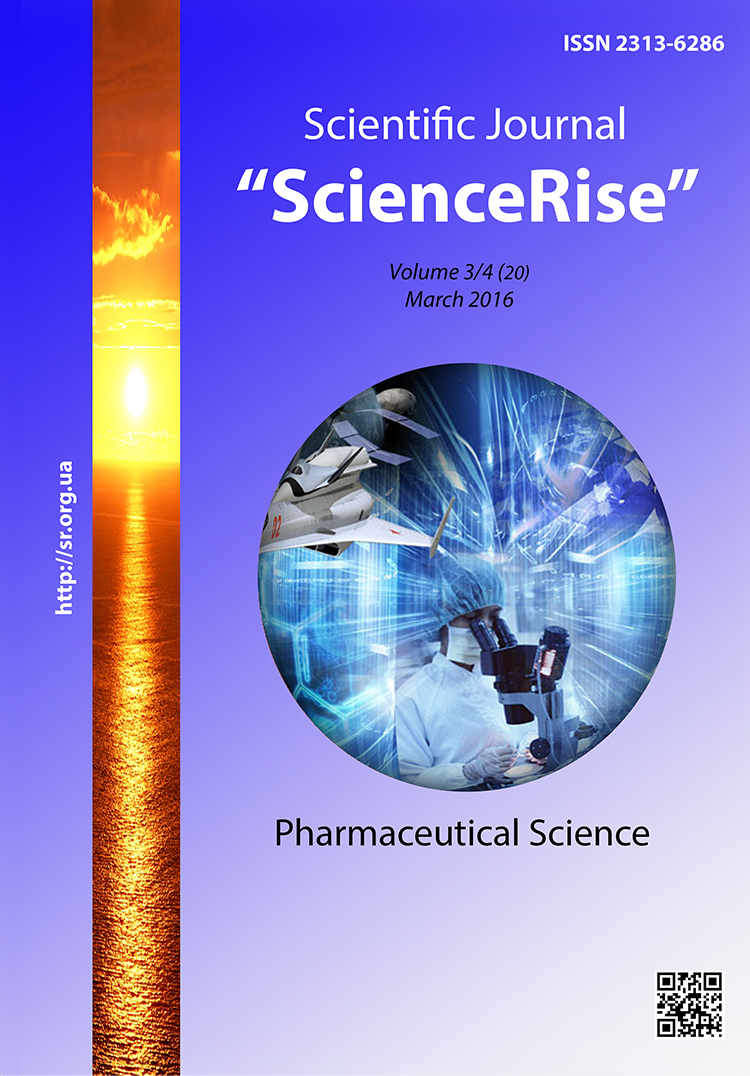Synthesis of the row of new functional derivatives of 7-arylalkyl-8-hydrazine theophyllines
DOI:
https://doi.org/10.15587/2313-8416.2016.65209Ключевые слова:
synthesis, 7, 8-disubstituted of 1, 3-dimethylxantine, hydrazine derivatives, spectral analysis methodsАннотация
Hydrazine functional derivatives are widely used in medical practice as remedies applied for pharmacotherapy of depression, infection diseases, hypertension, diabetes, etc. It is worth mentioning that among obtained 7-R-8-hydrazine derivatives of 1,3-dimethylxantine promising substances have been identified. Due to the fact that literature sources display only results of occasional studies of the reactions between 7-R-8-hydrazine theophyllines and mono- or dicarbonyle substances, the use of other keto reagents for xanthine bicycle at 8th position functionalization will allow to explore synthetic potential of the last one, and with high probability may lead to obtaining original biologically active substances.
Aim. To study types of reaction between 8-hydrazinyl-1,3-dimethyl-7-aryl alkyl-1H-purine-2,6(3H,7H)-diones and a number of carbonyl containing reagents.
Methods. A nucleophilic addition reaction followed by dehydration or ethanol splitting was used, as well as the complex of the modern analysis methods to confirm the structure and individuality of the synthesized substances.
Results. Different directions of 8-hydrazinyl-1,3,-dimethyl-7(fenetyl-, 3-phenylpropyl-, 3-phenylalyl)-1H-purine-2,6(3H,7H)-diones chemical transformations in reactions with the appropriate carbonyl containing compounds have been studied experimentally. The structure of synthesized substances was confirmed by chromatography/mass and 1H NMR spectroscopy.
Conclusion. The group of 7-arylalkyl-8-(3,5-R,R1-pyrazole-1-yl)theophyllines, consisting of two functionally substituted bioactive heterocycles, has been synthesized by reaction between initial substances and selected mono- and dicarbonyl compounds
Библиографические ссылки
Zelenin, K. N. (1998). Gidrazin. Sorosovskij obrazovatel'nyj zhurnal, 5, 59–65.
Mashkovskij, M. D. (2012). Lekarstvennye sredstva. 16th edition. Moscow: Novaja volna, 1216.
Sweetman, S. C. (Ed.) (2009). Martindale: The Complete Drug Reference. Thirty-sixth edition. Pharmaceutical Press, 3694.
Rollas, S., Küçükgüzel, S. G. (2007). Biological Activities of Hydrazone Derivatives. Molecules, 12 (8), 1910–1939. doi: 10.3390/12081910
Narang, R., Narasimhan, B., Sharma, S. (2012). A Review on Biological Activities and Chemical Synthesis of Hydrazide Derivatives. Current Medicinal Chemistry, 19 (4), 569–612. doi: 10.2174/092986712798918789
Mosselhi, M. A. N., Tawfik, N. M., Shawali, A. S. (2003). New [ e ]-Fused Caffeines: A Simple Synthesis of 3-Substituted [1,2,4]Triazolo[4,3- e ]purines. Monatshefte Fur Chemie/Chemical Monthly, 134 (4), 565–571. doi: 10.1007/s00706-002-0514-7
Petch, D., Anderson, R. J., Cunningham, A., George, S. E., Hibbs, D. E., Liu, R. et. al. (2012). Design and synthesis of EGFR dimerization inhibitors and evaluation of their potential in the treatment of psoriasis. Bioorganic & Medicinal Chemistry, 20 (19), 5901–5914. doi: 10.1016/j.bmc.2012.07.048
Ashour, F. A., Rida, S. M., El-Hawash, S. A. M., ElSemary, M. M., Badr, M. H. (2011). Synthesis, anticancer, anti-HIV-1, and antimicrobial activity of some tricyclic triazino and triazolo[4,3-e]purine derivatives. Medicinal Chemistry Research, 21 (7), 1107–1119. doi: 10.1007/s00044-011-9612-6
Korobko, D. B., Berezovs'kyj, O. V., Palagnjuk, M. M., Pylypiv, Je. S. (2011). Syntez i fizyko-himichni vlastyvosti dejakyh 7-aralkil-(alkenil)-8-bromo-(tio-)teofiliniv. Liky – ljudyni. Harkiv, 263–269.
Abdel-Wahab, B. F., Abdel-Gawad, H., Mohamed, H. A., Dawood, K. M. (2010). Utility of 2,4-Dioxoesters in the Synthesis of New Heterocycles. HETEROCYCLES, 81 (1), 1–55. doi: 10.3987/rev-09-659
Gumennoj, V. P. (1984). Kondensacija 1,3-dikarbonil'nyh soedinenij s 8-gidrazinoksantinami. Chem. Abstrac., 101 (13), 110869.
Povstjanoj, M. V., Kruglenko, V. P., Kljuev, N. A. et. al. (1992). Kondensirovannye imidazo-1,2,4-aziny. XXVI. O reakcii 8-gidrazinoksantina i 8-(1-metilgidrazino)teofillina s acetil- i benzoilacetonom. Zhurnal org. himii, 28 (4), 849–856.
Voskobojnik, O. Ju. (2008). Syntez, peretvorennja, fizyko-himichni ta biologichni vlastyvosti [{2-R-(3H)-[hinazolin-4-iliden}gidrazono]karbonovyh kyslot. L'viv. nac. med. un-t imeni Danyla Galyc'kogo, 26.
Tarasevich, B. N. (2012). IK spektry osnovnyh klassov organicheskih soedinenij. Spravochnye materialy. Moscow: MGU, 55.
Silverstein, R. M., Webster, F. X., Kiemle, D. J. (2005). Spectrometric identification of organic compounds. 7 edition. John Wiley & Sons Ltd, USA, 267.
Загрузки
Опубликован
Выпуск
Раздел
Лицензия
Copyright (c) 2016 Dmytro Korobko

Это произведение доступно по лицензии Creative Commons «Attribution» («Атрибуция») 4.0 Всемирная.
Наше издание использует положения об авторских правах Creative Commons CC BY для журналов открытого доступа.
Авторы, которые публикуются в этом журнале, соглашаются со следующими условиями:
1. Авторы оставляют за собой право на авторство своей работы и передают журналу право первой публикации этой работы на условиях лицензии Creative Commons CC BY, которая позволяет другим лицам свободно распространять опубликованную работу с обязательной ссылкой на авторов оригинальной работы и первую публикацию работы в этом журнале.
2. Авторы имеют право заключать самостоятельные дополнительные соглашения, которые касаются неэксклюзивного распространения работы в том виде, в котором она была опубликована этим журналом (например, размещать работу в электронном хранилище учреждения или публиковать в составе монографии), при условии сохранения ссылки на первую публикацию работы в этом журнале .

